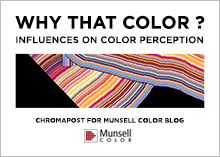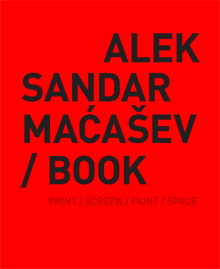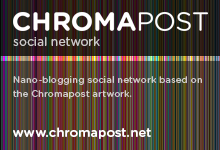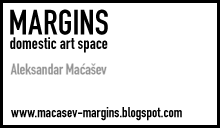link to the original article>
In the present atheist-awareness situation there has been a lot of discussion about a possible atheist logo or symbol. Every group needs some visual representation for easy recognition in a political arena, a public debate, or the marketplace. A visual sign such as a symbol or a logo summarizes in a nutshell a group's common cause, in a way that is easy to read and understand. But do atheists really need a symbol? Just for the sake of argument, let's say we do.
The problem is - how to define atheists as a group? Atheists are non-believers, as simple as that. But it is not just a denial (an anti-something), nor general non-believing in anything, it is a world view that does not include any kind of deity or a supreme and supernatural being. Atheists have never been an organized group that fought religion, but rather a disparate group of individuals who do not believe in god. They come from various already recognized groups: scientists, philosophers, skeptics, historians, artists, writers... . And through the course of history, as far as I know, there has never been a long lasting symbol attached to atheism. There is a good reason for this. It never was an "official" group. Dawkins' remark about herding cats is quite correct. Atheists are mainly skeptics and hard-core individuals without tendencies of gathering in groups. We often don't share all the same ideas/interests. But we do share some of them.
With the emergence of online atheist discussions, chats and publications, you can feel already feel a sense of a group. And that group wants to be recognized. On a couple of Internet forums I have found very interesting discussions about what should be the symbol or the logo for atheism. But first of all, let us make an important distinction between these two.
Symbols are complex phenomena that includes emblems, metaphors, attributes, analogies, symptoms, and parables. Symbols summarize and represent various more or less complex ideas and concepts. Interpretations of symbols are very elusive and very often are just clouds of probability. Very often a symbol has its visual representation in a form of a graphical symbol. Such a sign is very often embedded in the cultural communication code, but its meaning could vary depending on the culture, context and moment in history. White symbolizes happiness and light in some cultures, while in others it symbolizes mourning. The color red can mean "stop", "danger" or "blood" depending on the context and usage. One of the most well known symbols to switch meaning through history, the swastika changed from a rather positive solar wheel to the symbol of the Nazi party. Some symbols tend to be very stable, like a Christian cross. The durability and stability of the symbol very often depends on the stability of the set of values it represents. Symbols are often very old concepts, developed through the ages with many layers of meanings. Some of them (mainly graphical symbols) could be very recent, like the "@" symbol, which brings the immediate association with an electronic mail communication. Graphical symbols sometimes do not have a direct semiological connection with the value it signifies (like @ and email). More generic and older symbols tend to maintain homogeneity of the signifier and the signified. Also, the genesis of a symbol is not usually a planned and programmed action, but is very often a result of the natural-cultural selection and spontaneous public consensus.
The logo, on the other hand, is the much more recent invention of commercial visual communication. It is a graphical symbol very often accompanied by logotype (typeface set in a unique manner) and it serves as a label for companies, products, political parties, various organizations and groups - any entity that needs to be noticed on the market. Resemblance between the graphical logo and the values of the particular product or a group that logo is associated with is sometimes optional. The connection is very often created through the means of the forced association of mass media. Repeated commercials and advertisements for Nike create a connection between a "swoosh" logo and the particular sportswear. Nike is the ancient Greek goddess of victory (one link here) and the symbol itself reminds us of movement (another link there). But many of the logos do not have such a convenient explanation. To put it very roughly, just brand yourself with whatever, like you would brand a cow, and you're ready to go.
I don't think atheism/atheists will get a recognized symbol any time soon. First of all you cannot apply a logo to such a complex and diverse category of people and thoughts. So, it would need to be a symbol, a graphical symbol. I have seen a lot of "symbols" invented by forum users and enthusiasts and they vary from light bulbs, unicorns and different math symbols to funny illustrations of Adam giving God a finger (c.f., Sistine chapel ceiling). They also vary in the quality of their execution and graphical precision, but they all seem to aim towards the ideas of science, skepticism, illumination, light and knowledge. Some of them are just mocking religion, like slashed crosses or Darwin Fishes and Spaghetti Monsters. The symbol of the circle with a slash overlay is very clear and attractive, but it implies total denial or even forbidding, which is not a very suitable for atheism, as it gives it the charge of being anti-something and therefore doomed. Pansy is very often used for secular organizations because of its name ("thought" in French). I myself like the symbol of a cat, because cats are unpredictable, individual and hardly herded. Just like atheists. A cat would probably get a lot of poison remarks from any counter-atheist when you consider other qualities of a cat: elusiveness, predatory, unfaithful. (There's an extensive collection of proposals at Internet Infidels Discussion Board)
Many of the proposed symbols that I have found rely on mythology and religion accordingly - atheist symbol should not be related to any kind of belief in supernatural beings, right? - and have different meanings in different cultures. Atheism as an aspect of the free thinking world should transcend cultural peculiarities. Let us see some of the proposals and meaning they are actually charged with.
The symbol of the unicorn in ancient China was a royal symbol related to the royal sense of justice. A horn that hits the guilty ones. In the Christian mythology the horn represents penetration of the divine into the profane. A mental phallus attached to the head. It also symbolizes the Virgin that was impregnated by the holy Spirit and her protection. There is often a very contradictory notion between the protection of virginity and the potency of the symbolical phallus. I remember unicorns as very strong symbols in Tennessee Williams' "Glass Menagerie" as well as in Ridley Scott's movie "Blade Runner".
If we strip the Darwin Fish of its ironic connotations we just get a fish that is a very strong symbol in most of the cultures and world religions. Fish was the avatar of Vishnu, a symbol of the corn god of the Indians of middle America, a token of happiness (along with a stork) in China. The early Christian fish was mostly related to the acronymically used word for the fish in Greek - Iesus Christos Theu Yios Soter.
The letter "A" is very much in use (A as in Atheist), but it has infamous connotations of the scarlet letter "A" known only to the westerners. Phoenicians took the "bull" hieroglyph and turned it into the first letter of the alphabet, A. As a Greek variation, alpha, it was combined with omega (another symbol used for atheism) to represent the beginning and the end. The letter "A" is used in Dawkins' The Out Campaign. The letter is slanted and, to be quite honest, reminds me very much of the "A" of AIGA (the American Institute of Graphic Arts). The letter "A" in a circle is a well known symbol of anarchy, thanks to the punk-rock pop cultural proliferation, I might add. It's not that there is no connection between anarchy and atheism, but the two symbols shouldn't be mixed.
Lemniscate, the math symbol for infinity or just "the lazy eight" was introduced by John Vallis in the XVII century and it is based upon the Roman numeral for 1000. It is also related to the small-caps already mentioned omega. The lazy eight has a very strong relation to the ouroboros, a snake that is devouring its tail, an ancient symbol of infinity, symbol of the Gnostics and could also be found on some Unitarian church emblems. The popular conception is that it represents Moebius strip.
The lightning symbol is charged with a variety of religious symbolism. Lightning is a symbol of the power and energy that creates balance. According to some Pygmy myths it is a divine phallus, and in some other cultures it is a punishment. Zeus' lightning stood for spiritual enlightenment. In Vedic tradition it is connected to water and purification. Many gods were thunderers, like Celtic Taranis or Nordic Thor. The lightning in the Tower card of the Tarot pack symbolizes god's wrath and fall of the man. The contemporary meaning of the graphical symbol is just electricity.
So, we need a logo. But as I said you cannot put a logo on atheism just like you cannot burn a brand on "illumination" or "skepticism". But, you can put a logo on various atheist initiatives as has already been done. "American Atheists", founded in the 60's, have an "atomic swirl" logo with an open bottom end (openness to new possibilities) and a letter "A" in the middle. It is quite modernist and scientific iconography, probably very popular at the time. Today, it reminds me of radioactivity. It is also used for marking military graves of atheists. Atheist Alliance International has the "@" sign for a symbol. I don't quite get the connection here. The Out Campaign for atheist outing is already discussed above. Infidels.org (Secular web) has a drop of water (how many times have you seen that?) with the slogan "a drop of reason in the pool of confusion". The community of the people with a naturalistic world view, The Brights, has a sun-like symbol. It reminds me of the Macedonian flag, and when used on dark background, the "sun" becomes dark. They use some sort of ghostly dots of light as an addition to their visual identity. And so on and so forth, every organization has it's own symbol according to its mission/vision statement.
I was thinking to myself, if I had all these inputs like a printed design brief on my desk, what would I do? What should be the unique signifier of atheism? And should I think of a symbol (a crazy task) or design a logo? (Well, I can't think of any particular group of atheists I would work for.) Let's say it could be a symbol and it could be adapted for commercial use too.
The first thing that comes to my mind is that a visual representation should not be a solid block, as the Christian cross is. It should represent the ever changing form of atheism on the one hand, and the stability of its essence on the other hand. If religion is a solid block, then atheism is an ever shifting sand. A solid block is easy to represent visually. Actually, it's a symbol already. Sand is about moving, changing shapes and moving borders, accepting possibilities. Something like the mentioned cloud of probability. It is harder to visually represent such a thing, but it is possible. It changes shape, but within clear borders and with a recognizable visual ingredients. There are very good examples of amorphous logos that still keep their essence no matter how we bend them. Such as Hanover Expo 2000 logo or Seed Media Group identity by Stefan Sagmeister. Such logos are very often animated and varied in print.
The other possible solution that came to my mind is an empty container that can be filled with whatever we find suitable. Like a square or a circle. We can fill it with cat/atom/bulb and if the "container" is clear enough the logo in it's entirety will always be recognizable. It is flexible enough and on the other hand it could be rather clear.
Any suggestions?























9 comments:
Thats really very ineteresting adn very informative...
cheers,
suma valluru
------------------------------------------
http://www.esumz.com
Thats really very interesting and very informative...
cheers,
suma valluru
------------------------------------------
http://www.esumz.com
Kada sam procitala ateizam i logo, dakle nista od slika jos uvek nisam videla, ali mi je pao na pamet upravo poslednji simbol (skroz desno) iz prve serije slika. Prazan, precrtan krug. Moja asocijacija je tacnije bila precrtan oreol. Ali sta sa religijama koje nemaju hriscansku simboliku? Definitivno nije lako. Treba sve nekako objediniti. Trenutno nemam ni jednu ideju vrednu pomena. Razumem problem sa A, ali sta je sa grckim alfa - ἄθεος (bez boga, godless)?
Ja inace verujem u boga, ali na neki sebi svojstven nacin koji jos uvek nije kompletno oformljen da bih ga tacno iznela. Potrudila sam se da uzmem iz razlicitih religija ono sto mislim da je najbolje. Crkve i ostale verske institucije volim da posetim, pa bila to dzamija, sinagoga, pagansko svetiliste i tako dalje, jer uzivam u arhitekturi i dozivljaju mesta i prostora i to je otprilike sve sto se tice moje veze sa organizovanim religijama. Smatram da su nase religije pogresno shvacene i jos gore iskoriscene. Nije da nisu donele nista lepo, ali su im negativne zasluge vece. Ja nista od toga ne mogu da razumem, tacnije receno razumem savrseno, ali ne mogu da se pomirim sa time. Dosla sam do tacke kada mi pitanje postojanja boga vise nije bitno, jer shvatam da nemam nikakvog uticaja na mene. Da se sutra dokaze da postoji ili ne postoji, to u mome zivotu ne bi promenilo ama bas nista, jer zivim onako kako mislim da je ispravno i zivim tako jer sam takvog karaktera i verujem u dobro, a ne zato sto se bojim da cu goreti u paklu i slicne gluposti.
Izvini ako sam smorila...
very cool site. I enjoyed your post.
How about a pendulum as the symbol? It's in constant motion, or at least it can be. It changes in direction when moved... I was reminded of it by this office toy I once saw. A pendulum hanging above a plate of sand, it was low enough that it could sort of engrave a pattern when pushed in whatever way.
Yeah, pendulum is an interesting idea. It's moving and you can never determine it's position. Just like electrons and all that cloud of probability stuff.
Maybe there is a reason for everything. Even Darwin answered to someone. Go with what you know. ~D
Man has consistently used around 10% of the brains capacity, yet so many hope to rely on their own logic and understanding to find answers to the eternal questions of life. Good luck.
Not that I believe in god(s) but, by organizing, creating logo and all, are you not also creating a religion where your god is the non-existance of god? Doesn't it require just as much blind faith to not believe in god as it does to believe in one or many? I mean the two concepts are polar opposites. Each and every individual has the potential to find their own answers to eternal questions, its just super important that one realizes their answers are not applicable to anyone else but them.
I appologize if I have offended anyone, but I do like to ask/present questions. Usually the ones that piss you off the most at first, yield the most gratifying answers in the end. Or not.
Post a Comment